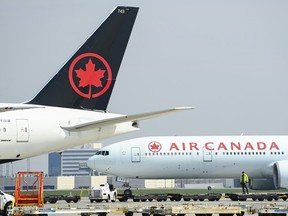Article content
MONTREAL — Canadian airlines have enjoyed a two-year boom amid consumer hunger for post-pandemic travel. But as that pent-up demand recedes, the country’s largest carrier hopes to ramp up ticket sales to corporate customers instead.

MONTREAL — Canadian airlines have enjoyed a two-year boom amid consumer hunger for post-pandemic travel. But as that pent-up demand recedes, the country’s largest carrier hopes to ramp up ticket sales to corporate customers instead.
Advertisement 2
Article content
Until recently, the travel surge that followed COVID-19 restrictions failed to reach the business world, where pandemic habits of video conferencing and remote work proved tough to shake.
Article content
But Air Canada, which reported a first-quarter earnings loss on Thursday, perceives signs of a shift.
“In Q1 it was relatively stable. We didn’t see a big growth, as some of our American peers did,” said Mark Galardo, head of revenue and network planning, referring to business travel.
“But as we look late into the quarter and into Q2, we’re starting to see some very encouraging signals on corporate demand _ to the tune of almost 10 to 20 per cent greater on a year-over-year basis.”
Air Canada said premium products — business cabin and premium economy fares — accounted for 30 per cent of growth in passenger revenue in its first quarter. The tickets yield fatter profit margins than lower-tier seats.
Article content
Advertisement 3
Article content
The bump hints at the potential demonstrated by U.S. carriers, which enjoyed a marked rebound in business travel.
Delta Air Lines posted a double-digit year-over-year leap in corporate sales in its first quarter. It expects record revenues from business passengers in the second, saying 90 per cent of its corporate clients aim to continue or increase their travel levels this quarter.
United Airlines’ chief financial officer said two weeks ago that its business bounceback was “wind in our sails,” with a forecast of stronger tailwinds to come.
Alaska Airlines raised its 2024 earnings prediction earlier this month on the assumption that corporate income will offset rising fuel costs. More travel spending by technology companies such as Microsoft and Amazon contributed to the increase, the carrier said.
Advertisement 4
Article content
Air Canada saw a similar trend. Executives in the tech and transportation sectors have returned to Canadian skies in greater numbers, “which is a very, very good sign for a rebuild on the corporate demand side,” said Galardo.
“It’s a little bit early to spike the ball on that, but we’re seeing some very, very strong signals.”
The income will be welcome. Air Canada lost $81 million in its first quarter, falling below analysts’ expectations even as revenue and capacity ramped up.
Canadians’ diminishing appetite for post-pandemic travel made for thinner margins on fares, while a 21 per cent year-over-year rise in labour costs drove up overall expenses, the company said.
“As expected, pent-up demand and ’revenge travel’ factors are slowing over time,” said Galardo.
Advertisement 5
Article content
“Winter is challenging every year,” added CEO Michael Rousseau, referring to what is traditionally the toughest quarter for North American carriers.
Nonetheless, the company boosted passenger revenues by nearly 11 per cent year over year in the quarter ended March 31.
It also reaffirmed plans to bolster capacity by between six per cent and eight per cent and increase adjusted earnings to between $3.7 billion and $4.2 billion this year.
However, the airline still expects to remain below its soaring 2019 capacity levels until 2025, five years after COVID-19 first hammered the travel industry.
On Thursday, Air Canada reported that it swung to a loss in its first quarter compared to net income of $4 million in the same period a year earlier.
Operating revenue rose seven per cent year over year to $5.23 billion in the three months ended March 31.
On an adjusted basis, the Montreal-based company said it lost 27 cents per diluted share in its latest quarter compared with an adjusted loss of 53 cents per diluted share in the same quarter last year.
While an improvement, the result fell short of analysts’ expectations of an adjusted loss of seven cents per diluted share.
Article content